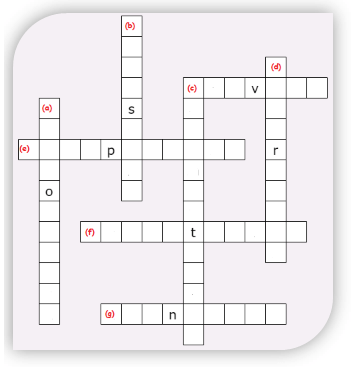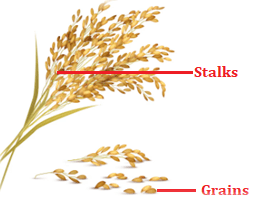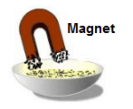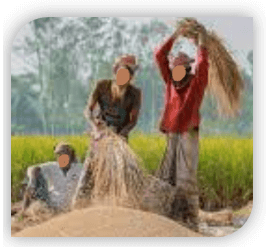Separation Of Substances Worksheet
Objective Type Questions
- Match the separation techniques in Column A with appropriate separation processes in column B:
(Column A) (Column B) i Evaporation a
Separation of tea leaves from boiled tea. ii Decantation b Separation of onions from potatoes iii Filtration c Separation of oil from water iv Winnowing d Separation of salt from seawater v Handpicking e Separation of grains from husk - State whether the following statements are true or false. In case of false statement, write the correct one.
(i) Iron powder mixed with flour is separated by sieving.
(a) True
(b) False
(ii) Lady’s finger mixed with beans is separated by winnowing.
(a) True
(b) False - Name the following:
(a) The process of removing upper layer of water from a heterogeneous mixture slowly.
(b) The process of conversion of water vapour into liquid water. - Find the odd one out:
• Mixture of chalk powder and water,
• Mixture of sugar and water,
• Mixture of sand and water,
• Mixture of oil and water. - Solve the following crossword based on “Methods of Separation of Mixtures”:
Down:
(a) The process of turning water into vapour
(b) The process separating grains from stalks
(c) The process of naturally allowing insoluble solid to settle down
(d) The process of separating chalk powder from water
Across:
(c) The process of separating impurities like bran from flour
(e) The process of separating small pieces of stones from pulses, rice
(f) The process of separating liquid from insoluble solid and other immiscible liquids, by removing the upper liquid layer.
(g) The process of separating chaff is separated from grain.
Multiple Choice Questions - Observe below image and suggest a method of separation.
(a) Winnowing
(b) Threshing
(c) Sieving
(d) Sedimentation - Teacher asked Meenal to separate a mixture of salt, sand and water. Which of the below options explain the stepwise processes required to get back all the three components separated?
(a) Evaporation to obtain sand, filtration to get salt, condensation to obtain water
(b) Filtration to get salt, condensation to get water, evaporation to remove sand
(c) Evaporation to get salt, filtration to remove sand, condensation to get back water
(d) Filtration to remove sand, evaporation to get salt, condensation to get back water - Lata's mother assigned her the task of washing rice for cooking. Lata added water to the bowl of rice and properly stirred it. She noticed that all of the dust particles had risen to the surface of the water, while the rice was settling. Which of the following separation procedures would be most helpful in removing dust particles?
(a) Decantation and condensation
(b) Filtration and evaporation
(c) Sedimentation and decantation
(d) Sedimentation and filtration - Shraddha’s father brought cauliflower, beans, tomatoes, oranges and limes from the market in a single cotton bag to avoid plastic bags. He asked Shraddha to help her mother keep it in the refrigerator properly. Her parents taught her to wash and dry all vegetables and fruits thoroughly before putting them in mini-cotton bags and storing them in the refrigerator. To do all these steps, she first had to separate all the vegetables and fruits. Which of the below separation method would be useful to do so and why?
(a) Handpicking because all the vegetables and fruits have different size
(b) Sieving because all the vegetables and fruits have different size
(c) Sedimentation because all the vegetables and fruits have different weights
(d) All the above three methods stepwise. - Kushal was asked to separate the beads collected in a glass? Based on what property these beads can be separated?
(a) On the basis of shape
(b) On the basis of size
(c) On the basis of colour
(d) On the basis of weight - Which of the following mixture would require below apparatus for separation?
(a) Copper chips and sulphur powder
(b) Marbles and sand
(c) Steel nails and iron nails
(d) Steel nails and sulphur powder - Now-a-days Ganpati visrajan is performed in artificial ponds to avoid pollution of natural water reservoirs. Which of the following would be the most appropriate method
for separation of clay and water?
(a) Sedimentation and evaporation
(b) Sedimentation and filtration
(c) Filtration and evaporation
(d) Decantation and condensation
Case-Based Questions - Many substances dissolve in water and form a solution. These substances are soluble in water. Shravan was instructed to do as follows:
I. Mix two teaspoons of solid salt with some liquid water in a beaker.
II. Stir it well. When he stirred it, he discovered that all of the salt had vanished, leaving only liquid in the beaker.
III. He was again asked to add few more teaspoons of salt in the same mixture and stir. He could see some salt undissolved.
IV. Heat the mixture formed in step III.
V. Cool the mixture formed in step IV.
(a) The liquid contained in the beaker at the end of procedure in step I:
A. Water
B. Solute
C. Solvent
D. Solution
(b) Which of the following methods will be most effective in extracting salt from the mixture prepared in step I?
A. Evaporation
B. Filtration
C. Condensation
D. Sedimentation
(c) Which method can be used to get liquid water from water vapours collected in another container?
A. Filtration
B. Sedimentation
C. Condensation
D. Evaporation
(d) What is the mixture formed in step III called? What will be the effect of heating on this mixture formed in step III?
(e) What would happen if the mixture formed in step IV is allowed to cool? Name the phenomenon.
Subjective Questions - On a vacation to her hometown, Kartiki noticed her uncles performing specific tasks in their farm, as shown in the photograph below. She was interested as to what they were up to. Can you explain this task and the underlying principle?
- Justify: Sugar is added to water before ice cubes while making chilled lemonade juice.
- Match the separation process mentioned in column A with the purpose of separation in column B and the treatment with separated components in column C.
Column A Column B Column C Type Separation process Purpose of separation Treatment with separated components I Churning of buttermilk (a) To remove solid not -useful component (i) We throw away the solid components. II Separation of stones from millets (b) To separate two different but useful components (ii) We use both the components III Separation of tea powder from boiled tea (c) To remove harmful impurities (iii) We throw away the harmful impurities.
Also, suggest the type with which the below mentioned separation process would fit:
Separation of salt from water.
Assertion Reasoning Questions
Below questions consist of two statements – Assertion (A) and Reason (R). Answer these questions selecting the appropriate option given below: - Assertion (A): Evaporation can be used to separate homogenous liquid mixture.
Reason (R): Evaporation is the process in which liquid gets converted into vapour. - Assertion (A): Sand can be separated from water by filtration.
Reason (R): Sand and water makes heterogeneous mixture. - Assertion (A): Pebbles and stones are removed from sand by sieving.
Reason (R): Sieving allows the fine particles to pass through the holes of the sieve while the bigger impurities remain on the sieve. - Assertion (A): The mixture of water and sand is separated by sedimentation.
Reason (R): The process of conversion of liquid water into water vapour is called evaporation.
Explore more Science Sample papers and Solutions
-
Sample Papers for CBSE Class 6 Science Term 1 #1
-
Sample Papers for CBSE Class 6 Science Term 2 #1
- Components Of Food Worksheet
- Sorting Materials Into Groups Worksheet
- Getting To Know Plants Worksheet
- Body Movements Worksheet
- The Living Organisms – Characteristics and Habitats Worksheet
- Motion And Measurement Of Distances Worksheet
- Light, Shadows And Reflections Worksheet
- Electricity and Circuits Worksheet
- Fun With Magnets Worksheet
- Air Around Us Worksheet
- Competency Based Questions for CBSE Class 6 Science
- Sample Papers for CBSE Class 6 Science Term 1 #2
- Sample Papers for CBSE Class 6 Science Term 2 #2








